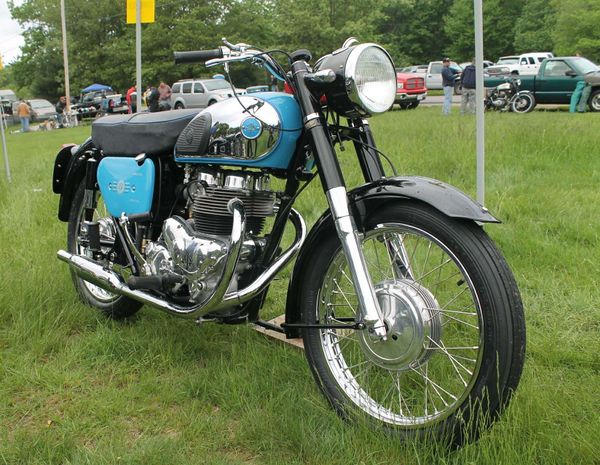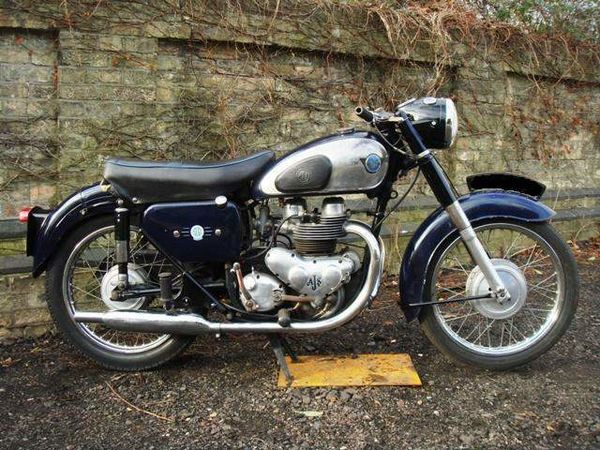AJS Model 30600
| File:AJS-MODEL-30.jpg | |
| AJS Model 30 | |
| Manufacturer | |
|---|---|
| Also called | Model 30600, Model 30 600 |
| Production | 1956 |
| Engine | Four stroke, pushrod parallel twin, OHV, 2 valves per cylinder, |
| Compression ratio | 7.0 : 1 |
| Top Speed | 95mph / 152 kph |
| Ignition | 6 Volt Magnet (Lucas K2F) |
| Transmission | 4 Speed |
| Frame | Single cradle |
| Suspension | Front: Hydraulic telescopic fork Rear: Dual chocks |
| Brakes | Front: Drum Rear: Drum |
| Front Tire | 3.25 -19 |
| Rear Tire | 3.50 -19 |
| Weight | |
| Fuel Capacity | 16 L / 4.2 US gal |
| Manuals | Service Manual |
It could reach a top speed of 95mph / 152 kph.
Engine[edit | edit source]
The engine was a Air cooled cooled Four stroke, pushrod parallel twin, OHV, 2 valves per cylinder,. The engine featured a 7.0 : 1 compression ratio.
Drive[edit | edit source]
Power was moderated via the Multi Plate (dry, Burman).
Chassis[edit | edit source]
It came with a 3.25 -19 front tire and a 3.50 -19 rear tire. Stopping was achieved via Drum in the front and a Drum in the rear. The front suspension was a Hydraulic telescopic fork while the rear was equipped with a Dual chocks. The Model 30600 was fitted with a 16 L / 4.2 US gal fuel tank.
Photos[edit | edit source]
Overview[edit | edit source]
AJS MODEL 30 600
Like most AJS roadsters, the 600cc Model 30 of the late 1950s suffered from a case of dual personality. Almost exactly the same bike, differing only in paint color, badges and exhaust system, was also sold as the Matchless Gil a result of the Wolverhampton-based AJS firm having been taken over by Matchless of London in 1931. The combined firm in turn became part of Associated Motor Cycles (AMC) in 1938, but the AJS and Matchless names were retained and used in an attempt to attract the continued support of each of the brand's enthusiasts. AJS had originally been founded by Albert John Stevens in Wolverhampton around the turn of the century, and won the Junior TT in 1914. But AJS's greatest racing feats came later, notably when Les Graham won the first ever 500cc world championship on the Porcupine twin in 1949. The most popular AJS racebike was the single-cylinder 350cc 7R, known as the "Boy Racer". Introduced in 1948, the 7R was hugely successful and was later enlarged to 500cc to make the Matchless G50. Most of AJS's roadsters were less spectacular singles and parallel twins such as the Model 30, whose 600cc engine had almost square dimensions, and gave a smoother ride than most other models. Peak output was only 33bhp but the twin was capable of cruising fairly smoothly at 70mph (112kph). Handling was predictable and made for a relaxed, comfortable bike over distances. The Model 30 was also well-made, reliable and economical. Unfortunately such attributes were not enough to keep AJS in business. Poor sales led to parent company AMC becoming part of Norton Villiers in 1967. Some AJS bikes were then built incorporating Norton parts, but they were not successful and the factory ceased production shortly afterwards.
| Make Model. | AJS Model 30 600 |
|---|---|
| Year | 1956 |
| Engine Type | Four stroke, pushrod parallel twin, OHV, 2 valves per cylinder, |
| Displacement | 593 cc / 36.2 cu in |
| Bore X Stroke | 72 x 72.8 mm |
| Compression | 7.0 : 1 |
| Cooling System | Air cooled |
| Induction | Carburetor |
| Ignition | 6 Volt Magnet (Lucas K2F) |
| Starting | Kick |
| Clutch | Multi Plate (dry, Burman) |
| Max Power | 24.6 kW / 33 hp @ 6800rpm |
| Transmission | 4 Speed |
| Drive | Chain |
| Frame | Single cradle |
| Front Suspension | Hydraulic telescopic fork |
| Rear Suspension | Dual chocks |
| Front Brakes | Drum |
| Rear Brakes | Drum |
| Front Tire | 3.25 -19 |
| Rear Tire | 3.50 -19 |
| Weight | 178 kg / 396 lbs |
| Fuel Capacity | 16 L / 4.2 US gal |
| Top Speed | 95mph / 152 kph |

